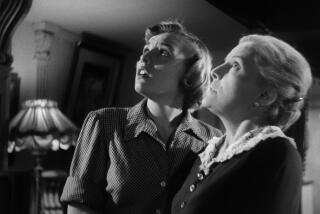New Ways Preserve the Old
In the fascinating new five-DVD set “The Movies Begin,” there are several examples of “blue movies” produced by American Mutoscope and Biograph studios in the early 1900s. Of course, these “peep shows” are incredibly tame by today’s standards. But back in 1908, “Fire in a Burlesque Theatre,” “Airy Fairy Lillian Tries on Her New Corsets,” “From Show Girl to Burlesque Queen” and “Troubles of a Manager of a Burlesque Show” were considered pretty hot stuff.
The first disc of the Kino set, “The Great Train Robbery and Other Primary Works,” also includes animated renderings of Eadweard Muybridge’s primitive motion studies from 1877-85. And a majority of the studies feature women in the full monty.
“Almost every new media has started with what passed as pornography at the time,” says David Shepard, who preserved and restored the films on three volumes of the set. The British Film Archive was responsible for the two other discs in the Kino set: “The European Pioneers” and “Experimentation and Discovery.”
This extensive study of the genesis of the motion picture was originally released on VHS format seven years ago, and three of its volumes, “The Great Train Robbery,” “The Magic of Melies” and “Comedy, Spectacle and New Horizons,” are also available on Image as part of its “Landmarks of Early Film” series. However, the Kino versions include more films.
Prior to this set, which arrives in stores today (suggested price: $100), the films had been available on video but only in terrible copies, says Shepard. Especially the films of the French pioneer who made “A Trip to the Moon.”
“The Georges Melies films were a real triumph,” says Shepard. “The Academy of Motion Picture Arts and Sciences had these beautiful 35-millimeter film fine grain [copies] that had been made in the 1940s from the original negatives. I was able to make an arrangement with them to use their fine grains. It took two months to patch up the fine grains so we could use them. Nobody had ever seen the Melies films looking that great. Then I had to wait a year for the composer, Alexander Rannie, because he was busy on other stuff. But it was worth waiting.”
The first volume includes several actualities--short documentaries that range from “President McKinley at Home” (1897) to “San Francisco: Aftermath of the Earthquake” (1906) and the gorgeous “Moscow Clad in Snow” (1908).
“Until about 1905, the actualities are what really dominated film,” says Shepard. “The only reason movies went over to fiction was because when the nickelodeon boon started, they needed to have a steady supply of product, and you couldn’t always count on interesting actualities happening in time to feed the theaters with their enormous appetites for titles. So they began to do fiction, and fictional film eventually dominated.”
The most enjoyable disc is “Experimentation and Discovery,” which features films made from 1898-1910 from both the U.S. and Western Europe. Included are the early works of the inventive British director-producer Cecil Hepworth, who made such films as the seminal 1905 thriller “Rescued by Rover,” which starred Hepworth’s own family and dog. “That was such a success that they wore out the negative,” says Shepard. “So they just got his wife and child and dog back and shot it a second time.”
G.H. Crick’s “A Visit to Peek Frean and Co.’s Biscuit Works” from 1906 features very sophisticated arc lighting and marks the beginning of the transition from the primitive actualities to the documentary style of today.
Also featured on the disc are several enjoyable fantasies from France’s Pathe Freres--including the color-tinted “Ali Baba and the Forty Thieves” from 1905 and “Aladin, or the Wonderful Lamp” from 1906. And from Edison Manufacturing Co., the first advertising film, 1898’s “Dewar’s--It’s Scotch.”
One of Shepard’s favorite films is “The Girl and Her Trust,” a 1912 romantic thriller from D.W. Griffith featured on the “Comedy, Spectacle and New Horizons” disc. The film, which was made near the end of Griffith’s tenure with Biograph, focuses on a feisty young woman (Dorothy Bernard) working at a train station who not only must hold off the advances of two suitors, but two bandits trying to steal the station’s money box.
The film, says Shepard, spotlights Griffith’s technical virtuosity. “The film has about 135 shots, which is about as much as you could imagine fitting into one reel,” he says. “It’s one of Griffith’s most fragmented films.”
And it’s one filled with sexual undertones. The film, says Shepard, “is basically a rape metaphor. Griffith buried this stuff pretty deep, but he was not naive. I have to think he knew he was making a film that was more than about a money box.”
Though Bernard was plucky and spunky in “The Girl and Her Trust,” Shepard says she didn’t make many movies for Griffith. “The scuttlebutt is that Griffith got her pregnant and sent her away,” he confides. “But I wasn’t there, so I don’t really know.”
More to Read
Only good movies
Get the Indie Focus newsletter, Mark Olsen's weekly guide to the world of cinema.
You may occasionally receive promotional content from the Los Angeles Times.










